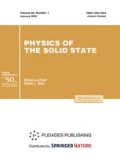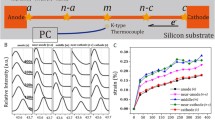Abstract
Chromium films with a thickness of 10–40 nm deposited onto silicon substrates by magnetron sputtering are subjected to the action of electric current induced by the tip of an atomic force microscope (AFM) cantilever in air under regular environmental conditions. The melting process at the nanoscale, electric field-induced migration of material, and the chemical reaction of chromium oxidation that occur in melt craters formed around the region affected by the current are investigated using optical and scanning electron microscopies, AFM, and Raman spectroscopy. The flow of melted material induced by electric current is accompanied by the formation and motion of an array of spherical nanoparticles in the melt crater along its periphery. We propose that the formation of nanodrop array at relatively low current densities can be explained by the chromium oxidation reaction and the surface tension of melted material on the silicon substrate.





Similar content being viewed by others
REFERENCES
S. Talukder, P. Kumar, and R. Pratap, IEEE Trans. Electron Dev. 60, 2877 (2013).
S. Talukder, P. Kumar, and R. Pratap, Science (Washington, DC, U. S.) 108, 2167 (2015).
S. Kumar, P. Kumar, and R. Pratap, J. Phys. D 50, 39LT02 (2017).
S. Krumbein, in Electromigration and Electronic Device Degradation, Ed. by A. Christou (Wiley, 1994).
Nanoscale Liquid Interfaces, Ed. by T. Ondar and J. P. Aimé (CRC, Taylor and Francis Group, Boca Raton, 2013).
J. Cahn, J. Chem. Phys. 66, 3667 (1977).
D. Bonn, J. Eggers, J. Indekeu, J. Meunier, and E. Rolley, Rev. Mod. Phys. 81, 739 (2009).
A. Oron, S. H. Davis, and S. G. Bankoff, Rev. Mod. Phys. 69, 931 (1997).
P. E. L’vov, V. V. Svetukhin, S. V. Bulyarskii, and A. A. Pavlov, Phys. Solid State 61, 1872 (2019).
J. Becker, G. Grün, R. Seemann, H. Mantz, Kh. Jacobs, K. R. Mecke, and R. Blossey, Nat. Mater. 2, 59 (2003).
R. V. Craster and O. K. Matar, Rev. Mod. Phys. 81, 1131 (2009).
X.-J. Cai, J. Genzer, and R. J. Spontak, Langmuir 30, 11689 (2014).
M. Kalloudis, E. Glynos, S. Pispas, J. Walker, and V. Koutsos, Langmuir 29, 2339 (2013).
J. E. Maslar, W. S. Hurst, T. A. Vanderah, and I. Levin, J. Raman Spectrosc. 32, 201 (2001).
V. P. Maiboroda, A. P. Shpak, and Yu. A. Kunitskii, Usp. Fiz. Met. 4 (3), 123 (2003).
M. M. Kolendovskii, S. I. Bogatyrenko, A. P. Kryshtal, and N. T. Gladkikh, Tech. Phys. 57, 849 (2012).
S. V. Dukarov, O. P. Kryshal, and V. N. Sukhov, in Wetting and Wettability (InTech, Rijeka, 2015), p. 169.
S. Labus, A. Malecki, and R. Gajerski, J. Therm. Anal. Calorim. 74, 13 (2003).
S. V. Dukarov, V. N. Sukhov, and I. G. Churilov, Vestn. KhNU, Ser. Fiz. 865 (12), 77 (2009).
S. von Gratowski, V. Koledov, V. Shavrov, S. Petrenko, A. Irzhak, A. Shelyakov, and R. Jede, in Frontiers in Materials Processing, Applications, Research and Technology (Springer, Singapore, 2018), p. 135.
Funding
The part of study concerning phase transitions at the nanoscale was supported by the Russian Science Foundation (project no. 17-19-01748), and the electromigration study was supported in part from the funds of grants of the Department of Science and Technology, Indian Government (DSTO 1759), and in part by the Russian Foundation for Basic Research (project no. 17-57-45129).
Author information
Authors and Affiliations
Corresponding author
Ethics declarations
The authors declare that they have no conflicts of interest.
Additional information
Translated by A. Kukharuk
Rights and permissions
About this article
Cite this article
Sharma, M., Kumar, P., Irzhak, A.V. et al. Melting and Electromigration in Thin Chromium Films. Phys. Solid State 62, 988–992 (2020). https://doi.org/10.1134/S106378342006027X
Received:
Revised:
Accepted:
Published:
Issue Date:
DOI: https://doi.org/10.1134/S106378342006027X




